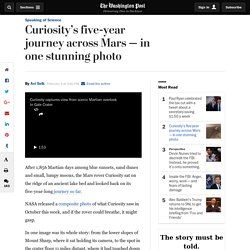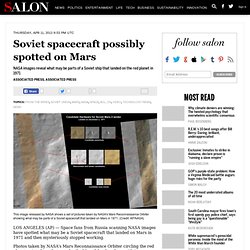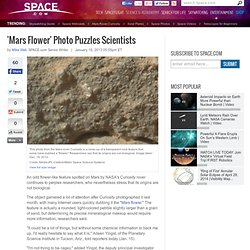

Incredible new images shared by Perseverance rover after Mars landing. The rover also returned some beautiful postcards of its landing site.

The first image shared during a NASA press conference Friday was "exhilarating" for the team when they received it. It shows the rover nearing the Martian surface during entry, descent and landing. A camera on the descent stage of the spacecraft captured the perspective, something that wasn't possible on previous missions. "This shot from a camera on my 'jetpack' captures me in midair, just before my wheels touched down," according to a tweet from the Perseverance Twitter account. "The moment that my team dreamed of for years, now a reality. NASA’s Curiosity Has Been On Mars For More Than 7 Years And Here Are Its 30 Best Photos. For us, mere mortals, Mars is a no man's land where survival seems like a distant dream.

After all, no man has ever walked on its surface (as far as we know) and plans to send one to the red planet are only in the early stages of its development. New Images from Mars Show NASA’s InSight Landed on an Absolutely Glorious Spot. Gizmodo. 25 amazing photos of Mars. NASA Curiosity panorama shows journey so far in one photo. Curiosity captures view from scenic Martian overlook in Gale Crater After 1,856 Martian days among blue sunsets, sand dunes and small, lumpy moons, the Mars rover Curiosity sat on the ridge of an ancient lake bed and looked back on its five-year-long journey so far.

NASA released a composite photo of what Curiosity saw in October this week, and if the rover could breathe, it might gasp. In one image was its whole story: from the lower slopes of Mount Sharp, where it sat holding its camera, to the spot in the crater floor 11 miles distant, where it had touched down five years earlier to great celebration on Earth.
As the most complex NASA instrument ever put on Mars, with its drill, laser and chemistry set, Curiosity has sometimes disappointed those who would mine its data for research. A NASA panel even chastised the robot — or its operators — for doing more sightseeing than science. Maybe for the same reason, Curiosity has brought Mars to life for the public. Mars Rover Spots Clouds Shaped by Gravity Waves. 22 Shares AP Photo/NASA/JPL-Caltech/Texas A&M/Cornell University NASA's Curiosity rover usually keeps its instruments firmly focused on Mars's ground, zapping grit with its laser or drilling cores in bedrock.

But every few days, the SUV-sized robot, like any good dreamer, shifts its sights upward to the clouds. Well into its fifth year, the rover has now shot more than 500 movies of the clouds above it, including the first ground-based view of martian clouds shaped by gravity waves, researchers reported here this week at the Lunar and Planetary Science Conference. Read Full Article » Mysterious Mars Mound May Be Result Of Ancient Lava Flows, NASA Says. Look at what two years on Mars did to the Curiosity Rover. Rough Road Ahead: Rocky Mars Terrain Challenges Curiosity Rover.
The Curiosity rover's wheels have taken a beating thus far on Mars, and the road ahead may be even rockier.

The 1-ton robot has just crossed out of its landing ellipse — the 12- by 4-mile (19 by 7 kilometers) zone that was targeted for its dramatic August 2012 touchdown — and is now moving toward an increasingly challenging landscape called the Zabriskie Plateau, mission team members said. "We are heading out into very rough terrain," Curiosity project scientist John Grotzinger, a geologist at the California Institute of Technology in Pasadena, said during a presentation at the 8th International Conference on Mars, which took place at Caltech last week. "These rocks have been a problem for us. " Soviet spacecraft possibly spotted on Mars. LOS ANGELES (AP) — Space fans from Russia scanning NASA images have spotted what may be a Soviet spacecraft that landed on Mars in 1971 and then mysteriously stopped working.

Photos taken by NASA’s Mars Reconnaissance Orbiter circling the red planet pointed to what may be the Mars 3 lander along with its parachute, heat shield and other hardware that it jettisoned during the descent through the thin Martian atmosphere. While scientists said the find appeared promising, more follow-up was needed to rule out other possibilities. Mars 3 operated for only 15 seconds on the Martian surface before it suddenly stopped communicating. It was part of a double mission the Soviet Union launched in 1971. Another Weird Shiny Thing on Mars. Want to stay on top of all the space news? 'Curiosity' Night PHOTOS: Mars Rover's First Images Of Martian Surface In Darkness. Are Those Spidery Black Things On Mars Dangerous? (Maybe) : Krulwich Wonders... You are 200 miles directly above the Martian surface — looking down.

This image was taken by the Mars Reconnaissance Orbiter on Jan. 27, 2010. (The color was added later.) What do we see? Well, sand, mostly. As you scroll down, there's a ridge crossing through the image, then a plain, then dunes, but keep looking. Michael Benson/NASA/JPL/University of Arizona/Kinetikon Pictures What are those things? As the sun gets hotter, they get more spidery. What could they be? Artist rendering by Ron Miller/JPL/Arizona State University "If you were there," says Phil Christensen of Arizona State University, "you'd be standing on a slab of carbon dioxide ice. That, anyway, is the leading explanation. We'll have to keep looking. A 2006 letter in Nature described this idea of geysers near the Martian south pole. Image of the Day. Amazing Mars Rover Curiosity's Latest Photos. 'Mars Flower' Photo Puzzles Scientists. An odd flower-like feature spotted on Mars by NASA's Curiosity rover continues to perplex researchers, who nevertheless stress that its origins are not biological.

The object garnered a lot of attention after Curiosity photographed it last month, with many Internet users quickly dubbing it the "Mars flower. " The feature is actually a rounded, light-colored pebble slightly larger than a grain of sand, but determining its precise mineralogical makeup would require more information, researchers said. "It could be a lot of things, but without some chemical information to back me up, I'd really hesitate to say what it is," Aileen Yingst, of the Planetary Science Institute in Tucson, Ariz., told reporters today (Jan. 15). Images of Mars from NASA’s Spirit & Opportunity Exploration Rovers.